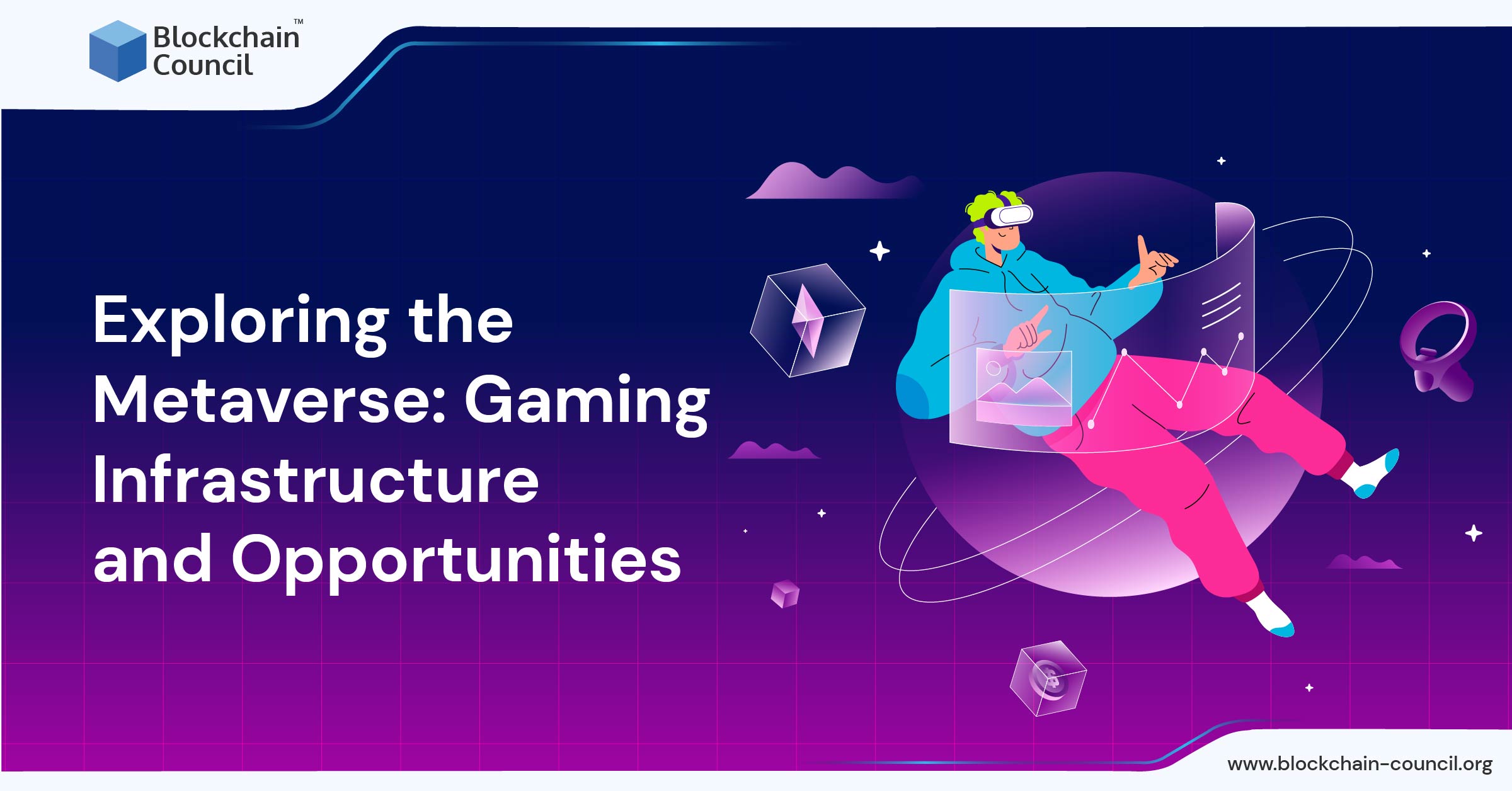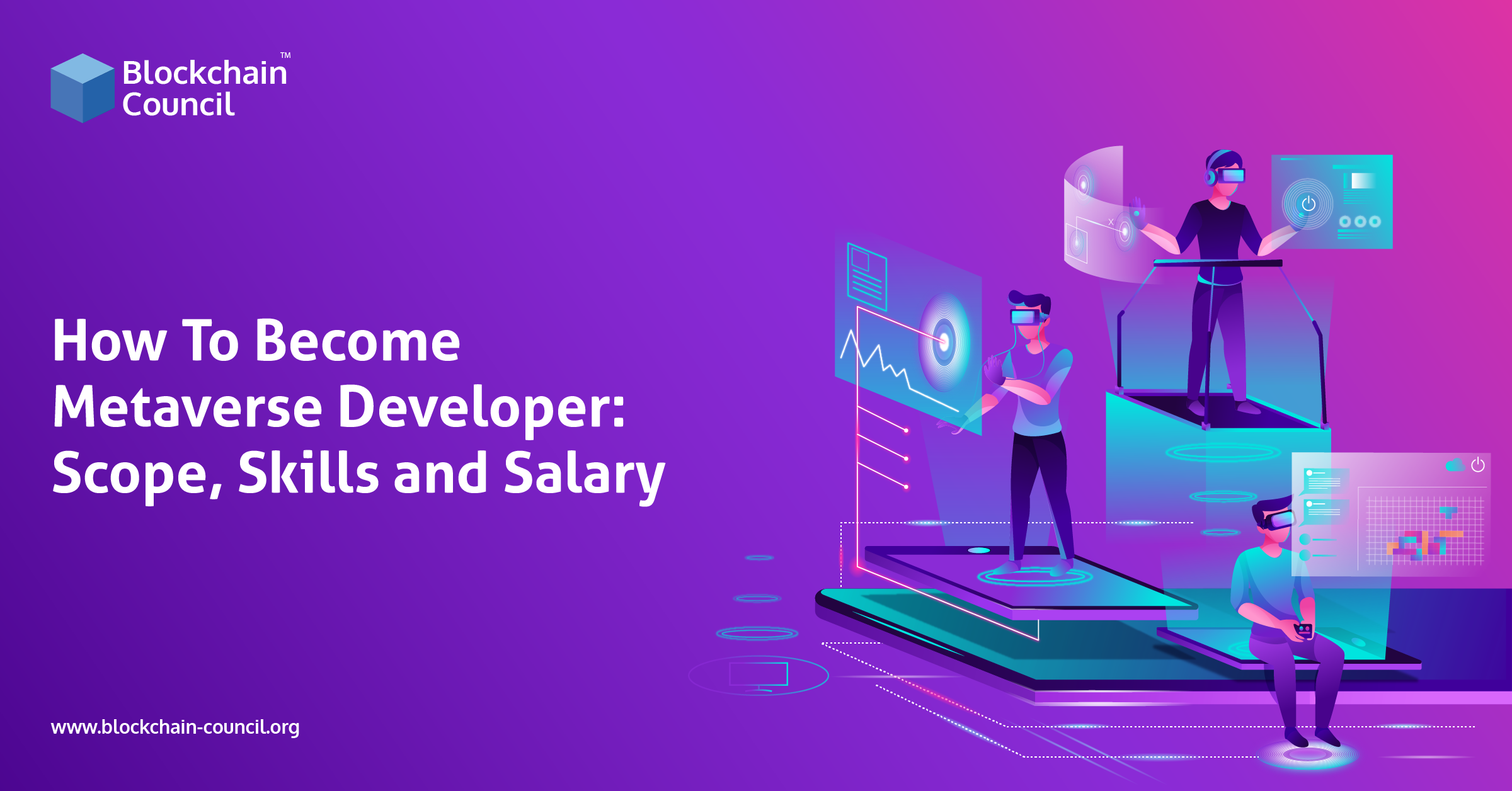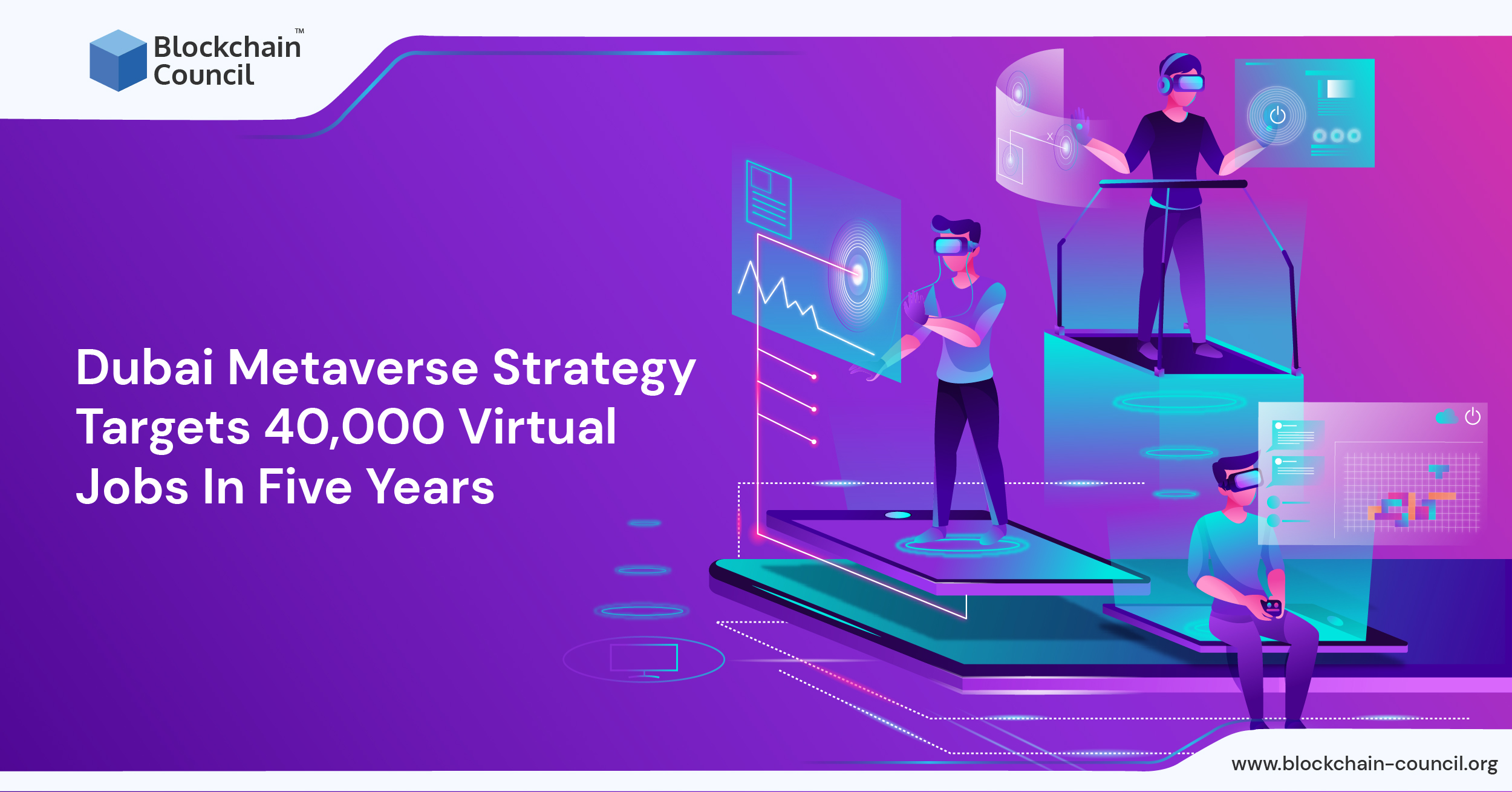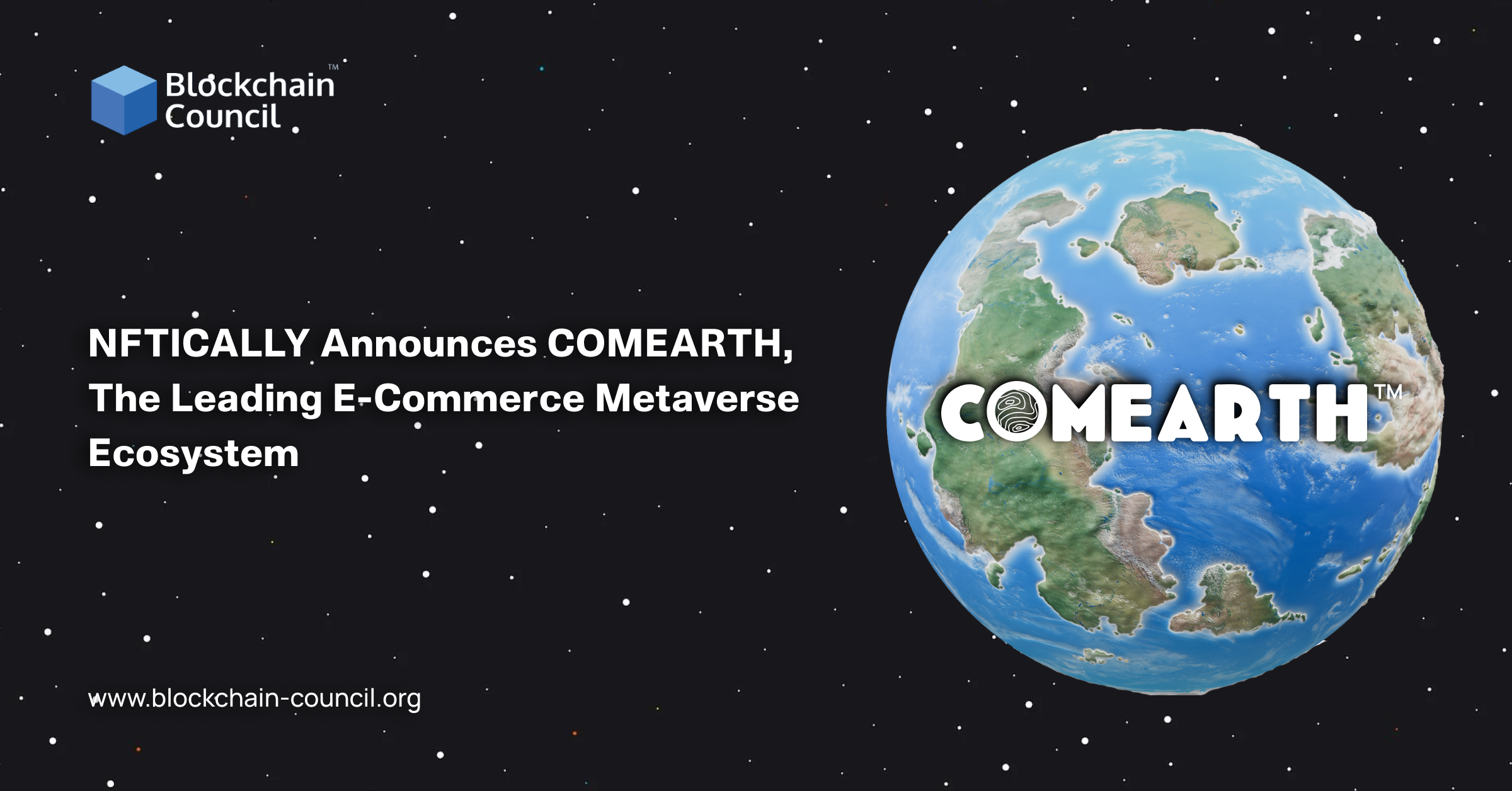
- Blockchain Council
- September 12, 2022
When Harry gifted a piece of virtual real estate to Elisa, his wife, as their 5th wedding anniversary gift, all she could do was gape at him with an open mouth. For the lady, the concept of a virtual land was completely new and horrifying, too, to some extent. She thought that her husband had wasted all his money on something that was not even real. Well, here we are talking about 2018, so Elisa’s nonchalant attitude towards the gift makes some sense now.
To be precise, we would have thought the same if we were in Elisa’s place. Rewinding the time cassette, we realize that investing in a land that exists in a virtual world would have taken anyone off the ground. This was because, back then, ‘Metaverse’ was a hidden gem whose sparkle was just starting to spread its charm. It was like a unicorn whose presence was known to the world, but its identity was way beyond anyone’s reach. Only people who had a craze for keeping links with the latest technologies would have heard about the word a few years back.
Interestingly, things have changed, and today Metaverse shines as one of the hottest trends in the tech space, attracting billions of dollars of cash flow in its trove.
Metaverse technology has been around for some time, but it was in 2021 that the concept shot to fame as we moved to a more digitalized economy. It represents a robust network of virtual spaces where users can interact, work, earn, socialize, and play with each other. With a thoroughly decentralized infrastructure, Metaverse celebrates the true essence of a liberal ecosystem where serving user interests is the top priority.
The Metaverse industry is penetrating deeper and emerging as a big player in the digital asset space. Different domains are stepping into the virtual space niche with their innovative projects and solutions. Following this trend, firms hailing from the e-gaming world have taken the lead and evolved as one of the most profitable junctions for the Metaverse ecosystem.
This article will explore the potential of Metaverse in unlocking new opportunities for the real estate and the gaming industry. We will discuss the future aspects of Metaverse in developing the two industrial realms. So, without much ado, let’s start our topic quickly:
Metaverse: The Big Talk
If we try to explain Metaverse in simple words, then we can say that it is a 3D digital world where virtual and reality come together to offer an immersive experience. Metaverse is curated on a blockchain network and incorporates next-gen versions of Virtual Reality, Augmented Reality, and Artificial Intelligence.
With Metaverse, users can enjoy seamless access to a decentralized ecosystem where technology blurs the line between reality and virtual. It offers a simulation of the physical world in a virtual setup clubbed with intuitive elements that seem too realistic to be called fake. The core infrastructure supports a wide range of activities that users fail to enjoy in the physical world. Metaverse blockchain is like a treasure trove with many surprises for its owners.
You can play games, go window shopping in a mall, create buildings and offices, trade assets, or visit your favorite tourist spot worldwide. All this and a lot more right at the comfort of your home. The technology allows users to create their personalized digital avatars or digital twins that do all represent them within the Metaverse. Smart glasses, VR-AR-supported headgears, handles, etc., allow users to navigate through the digital world easily. There is no limit to Metaverse. You can let your imagination run wild when in your digital self and enjoy the power of technology in its best version.
The word Metaverse first appeared in 1982 when Neil Stevenson launched his novel Snow Crash, where his characters switched between reality and virtual worlds in the story plot. While Metaverse came later, 3D and Virtual Reality technologies have been actively ruling the market since the early 80s. Where these pushes helped Metaverse grow, the situation did not change much before Facebook chief Mark Zuckerberg entered the picture. The spearhead changed his firm’s name to Meta Platforms to publicly show his interest in the fast-developing Metaverse field.
All these twists and turns played a significant role in shaping the Metaverse craze we are seeing now. If expert reports are anything to go by, then the future has much to offer for Metaverse fans.
How Metaverse Empowers E-Gaming?
It would be an understatement to say that Metaverse is growing because the sector is soaring with each passing milestone. Funds are flowing from all directions along with rigorous support from the biggest money magnates and brightest brains in the tech space. By offering a highly-intuitive visual experience to its users, Metaverse brings into light a futuristic reality that was only possible in movies earlier.
One of Metaverse’s biggest attractions is that it is for everyone, irrespective of the kind of work they pursue. Different industrial fields are actively adopting Metaverse technology as a resource to gain an edge over their competitors.
Interestingly, while the hustle to lead is still on, the gaming sector is already on the next level of the Metaverse spree. Undoubtedly, the domain was one of the earliest adopters of the technology, which has helped it gain the early-bird benefits easily. Metaverse gaming has become a trend amongst those who spend hours and bulks of money in the world of online gaming. With blockchain technology as part of its underlying architecture, metaverse games offer high-end security, transparency, and a provably fair gaming experience.
Metaverse Gaming Technologies
The following technologies facilitate the development of a metaverse gaming cluster:
-
Blockchain Technology
Blockchain technology is one of the most essential elements of a metaverse gaming project. As metaverse supports decentralization as its core principle, DLT helps to achieve the desired objectives to the fullest capacity. Decentralized games are free from the control of central authorities and offer a user-friendly interface for players.
The gamers get to enjoy access to a wide range of perks, including digital ownership proof, value transfer, immutability, etc. The use of digital avatars makes everything work smoothly in a metaverse game.
Metaverse wallet allows users to store their assets securely without any hassle in fund flow during transactions. It also helps users control their in-built purchases made in the metaverse gaming setup. Unlike traditional gaming, blockchain helps metaverse gamers to relish ownership rights over their digital assets even after they quit playing. As they are built on blockchain, they are easily exchangeable or tradeable on exchanges.
-
Cryptocurrencies and NFTs
Virtual assets are an inevitable part of a metaverse game. These virtual currencies create the economy in virtual spaces. They work in a similar fashion to real-world currencies by allowing users to transact, purchase digital assets, and lock deals with each other. Users use digital assets to transfer value in the metaverse world. The flow of cryptocurrencies is easily traceable, and they are free from intrusions to a bigger extent when compared to traditional fiat money. Non-Fungible Tokens have become immensely popular within the blockchain gaming sphere.
-
VR-AR Technologies and IoT
Virtual and Augmented Reality technologies offer an immersive experience to the users while playing. They create a replica of real-world items in the virtual world with added elements of human instincts. For instance, players can experience real-life thrill, anxiousness, and excitement while playing a game. These technologies allow them to feel increased heartbeat and breathing rate when fearing a clash with the enemy. Digital avatars perceive the surroundings and react humanly to each change.
Internet of Things or IoT allows metaverse users to collect, use, and store reliable and accurate data from the physical world. It serves as a link between billions of IoT devices and metaverse. The technology makes the virtual space more immersive, user-centered, and intuitive.
Characteristics of Metaverse Games
Metaverse unlocks the next level of online gaming experience for fans. They support decentralization which proudly stands tall as the future of tech evolution. Some of the main characteristics of metaverse games that form an essential part of any top-rated metaverse training program curriculum are:
-
Digital avatars
Virtual humans or digital avatars are the main characteristic feature of a metaverse gaming project. They represent the players within the virtual setup and allow them to explore the space. Through these miniatures, players can experience the fun of the game in the most realistic way. They react to situations in a human-like fashion giving similar sensations to the user. Digital avatars make the whole metaverse gaming experience user-friendly as the players enjoy anything and everything without being present there.
-
Play-to-Earn Games
Play-to-Earn games unlock a new domain of internet gaming. They allow players to earn digital assets while participating in a metaverse game. This can include earnings in the form of cryptocurrencies, NFTs, etc. The virtual gaming assets collected here can be easily traded or exchanged in crypto exchanges and NFT markets against fiat. Interoperability allows gamers to move their digital items from one place to another without any risk or alterations. Also, as the assets reside within the blockchain channel, they provide ownership rights to the owners. They enjoy free control over their assets irrespective of their status in the game.
-
Real-life Experience
Using AR, VR, and IoT, Metaverse offers an organic gaming experience to players. The level of physical world activities is increased by adding eye-catching elements. Metaverse games strive to provide a lifelike gaming experience full of thrill and excitement in the comfort of our homes.
Popular Metaverse Games
-
Axie Infinity
Axie Infinity is a popular P2E metaverse game that comes packed with action and thrill. Created by Vietnam-based Sky Mavis, Axie Infinity uses NFTs to empower its economy. It supports ETH-based assets or SLPs as payment tools within the cluster. The main characters in the game are called Axies, who are like cute domestic pets. Players can breed them, play with them, or trade them to earn rewards.
-
The Sandbox
It allows gamers to play, build, own, control, and trade virtual pieces of land in a metaverse ecosystem. Through self-designed NFT characters, players can indulge in all the activities they aspire to do in their virtual space. It is quite similar to Minecraft.
The Sandbox is an Ethereum-based metaverse game that offers a sense of ownership rights to the creators and land owners. Players can earn rewards by creating and building on their land. The game uses its native currency, called SAND, to run its economy. Renting out their land and land assets allows players to earn passive income.
-
Farmer’s World
The game is quite similar to Farmville. Here, players need to build their individual farmlands, manage their plantations, and pet their animals. The game rewards the players each time they fulfill their farming duties well. They can also compete with other players by visiting their farms and hustling for resources within the game. In-built assets in the game include agricultural equipment, virtual farmlands, and other farming essentials.
-
Sorare
Sorare is a perfect game for football fans. Developed on the Ethereum blockchain, Sorare uses NFTs to control and manage its economy. More than 180 popular football clubs have joined Sorare. Users can easily enter the game by creating a free account by registering their email details. They can purchase the NFT cards for the game using credit and debit cards or through bank transfers. Each week, the team that gathers the highest points in the game is allowed to create new NFT cards as a reward.
-
Decentraland
Launched in 2017, Decentraland is a blockchain-based 3D platform using the Ethereum blockchain network. The game allows users to build virtual structures of their choice within the metaverse. They can create parks, movie halls, malls, art galleries, concert halls, and other venues. The virtual spaces created in the game are called LAND, which is an NFT divided into 16mx16m parcels. The community members own these parcels, and users can purchase them using the native currency called MANA. The game is quite popular and has a market presence globally.
-
Plants vs Undead
The game was influenced by the well-known game called Plants vs. Zombies. It is a multiplayer game that uses NFTs as virtual plants. Players battle zombies utilizing the products of their plants in the game’s Planet Plants environment in an effort to save the Mother Tree. Users can invest in the built-in assets, engage in multiplayer games, and carry out regular duties to earn lucrative rewards. Players must plant seeds and care for them until they grow into plants. Users are able to buy, sell, and exchange plant products and seeds on the native market.
Final Thoughts
Metaverse gaming is surely one of the hottest trends to pursue presently. It comes packed with a pool of unraveled opportunities that are yet to be discovered by the tech geeks. Decentralized infrastructure, an NFT-based economy, and a P2E gaming model are some of the most coveted perks metaverse offers to its users. The blockchain gaming sector has immense potential to unlock a network that allows users to play, trade, and earn freely without any restrictions from financial regulators.
In my opinion, this is the perfect time for you to indulge in metaverse gaming to make the most out of the popping opportunities. So, Blockchain Council can be your guide if you are in. The platform offers a diverse metaverse course list to learn from. The programs offer detailed knowledge of all the core concepts related to the sector.





































































 Guides
Guides News
News Blockchain
Blockchain Cryptocurrency
& Digital Assets
Cryptocurrency
& Digital Assets Web3
Web3 Metaverse & NFTs
Metaverse & NFTs
